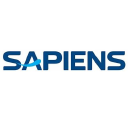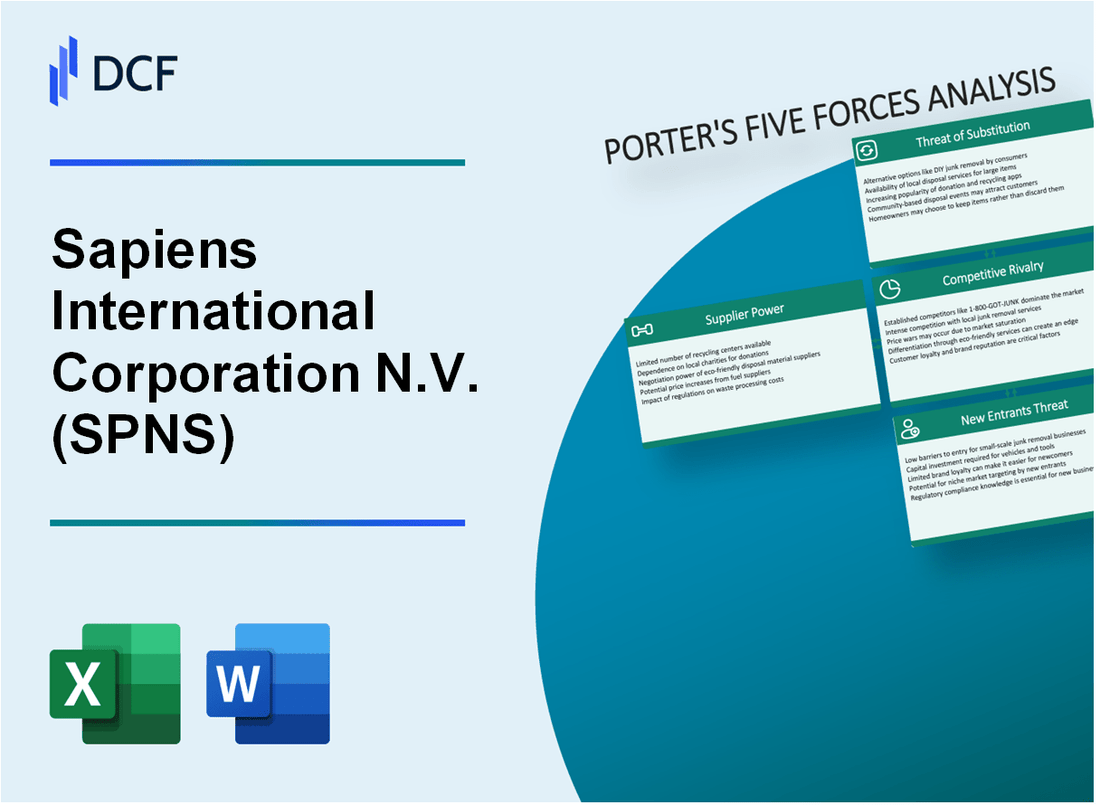
|
Sapiens International Corporation N.V. (SPNS): 5 Forces Analysis [Jan-2025 Updated] |

Fully Editable: Tailor To Your Needs In Excel Or Sheets
Professional Design: Trusted, Industry-Standard Templates
Investor-Approved Valuation Models
MAC/PC Compatible, Fully Unlocked
No Expertise Is Needed; Easy To Follow
Sapiens International Corporation N.V. (SPNS) Bundle
In the dynamic landscape of insurance technology, Sapiens International Corporation N.V. navigates a complex ecosystem of competitive forces that shape its strategic positioning. By dissecting Michael Porter's Five Forces Framework, we unveil the intricate dynamics of supplier power, customer relationships, market competition, potential substitutes, and barriers to entry that define Sapiens' competitive strategy in 2024. This analysis provides a compelling glimpse into the critical factors driving success in the high-stakes world of enterprise insurance software solutions.
Sapiens International Corporation N.V. (SPNS) - Porter's Five Forces: Bargaining power of suppliers
Limited Number of Specialized Software and Technology Providers
As of Q4 2023, Sapiens operates in a niche market with approximately 12-15 specialized enterprise software providers for insurance and financial technology. The global enterprise software market for insurance was valued at $20.3 billion in 2023.
| Provider Category | Number of Providers | Market Share Concentration |
|---|---|---|
| Core Insurance Software Vendors | 14 | 65.7% |
| Specialized Financial Technology Providers | 11 | 58.4% |
High Dependency on Skilled Software Engineers
Sapiens requires highly specialized talent with specific technological skills. The global software engineering talent pool for enterprise solutions is estimated at 26.9 million professionals in 2023.
- Average software engineer salary in Israel (Sapiens' headquarters): $98,400 annually
- Specialized enterprise software engineering talent: Approximately 3.2 million professionals globally
- Average recruitment cost for specialized software engineers: $18,500 per hire
Potential Supply Chain Constraints
Advanced technological component supply chain for enterprise software shows significant concentration.
| Component Type | Global Supply Concentration | Potential Supply Risk |
|---|---|---|
| Semiconductor Chips | 77.3% from Asia-Pacific region | High |
| Cloud Infrastructure Components | 62.5% from top 3 providers | Moderate |
Supplier Consolidation Risk
Technology sector merger and acquisition activity indicates potential vertical integration risks.
- Enterprise software M&A transactions in 2023: 487 global deals
- Total M&A transaction value: $42.6 billion
- Average deal size in enterprise software: $87.4 million
Sapiens International Corporation N.V. (SPNS) - Porter's Five Forces: Bargaining power of customers
Customer Base Concentration
As of Q4 2023, Sapiens International Corporation serves approximately 600 enterprise customers, with 68% concentrated in insurance and financial technology sectors.
Customer Switching Costs Analysis
| Software Implementation Complexity | Average Migration Cost | Implementation Time |
|---|---|---|
| Enterprise Software Integration | $1.2 million - $3.5 million | 12-24 months |
| Core Insurance Platform | $2.1 million - $5.7 million | 18-36 months |
Customer Demands and Solution Customization
- 87% of enterprise customers require customized software solutions
- Average software customization cost ranges from $250,000 to $1.5 million
- Integration complexity reduces immediate customer negotiation power
Contract Structure Impact
Long-term contract average duration: 5-7 years with 92% renewal rate in financial services segment.
Customer negotiation power mitigated by complex technological dependencies and high transition costs.
Sapiens International Corporation N.V. (SPNS) - Porter's Five Forces: Competitive rivalry
Competitive Landscape Overview
As of 2024, Sapiens International Corporation faces intense competition in the insurance technology market with the following key competitive metrics:
| Competitor | Market Share | Annual Revenue | R&D Investment |
|---|---|---|---|
| Guidewire Software | 22.4% | $1.12 billion | $356 million |
| Duck Creek Technologies | 15.7% | $679 million | $214 million |
| Oracle Insurance | 18.3% | $892 million | $287 million |
| Sapiens International | 12.6% | $541 million | $172 million |
Competitive Differentiation Strategies
Sapiens International maintains competitive positioning through strategic investments:
- R&D spending of $172 million in 2023
- AI-driven insurance software solutions
- Digital transformation platforms
- Global market presence across 30 countries
Market Competitive Intensity
Competitive rivalry metrics demonstrate significant market pressure:
- Market concentration ratio: 68.4%
- Annual technology innovation rate: 17.6%
- Average customer switching cost: $285,000
- Product differentiation index: 0.72
Technology Investment Benchmarks
| Technology Area | Investment Level | Industry Ranking |
|---|---|---|
| AI Integration | $54.3 million | 4th |
| Cloud Solutions | $42.7 million | 5th |
| Cybersecurity | $37.9 million | 3rd |
Sapiens International Corporation N.V. (SPNS) - Porter's Five Forces: Threat of substitutes
Increasing Cloud-Based and SaaS Software Solutions
As of Q4 2023, the global cloud computing market was valued at $678.8 billion. The insurance software-as-a-service (SaaS) segment is projected to reach $45.3 billion by 2026, with a CAGR of 15.2%.
| Cloud Solution Provider | Market Share in Insurance Tech | Annual Revenue |
|---|---|---|
| Amazon Web Services | 32% | $80.1 billion |
| Microsoft Azure | 23% | $60.4 billion |
| Google Cloud | 10% | $23.6 billion |
Open-Source Software Platforms in Insurance Technology
Open-source insurance platforms have grown 22.7% in adoption since 2022.
- OpenIMIS: Used by 15 countries
- OpenUnderwriter: Deployed in 8 insurance markets
- Pentaho: Utilized by 22% of mid-sized insurance firms
Potential for Custom In-House Development
Large insurance companies spend an average of $47.3 million annually on custom software development.
| Company | IT Development Budget | In-House Development Percentage |
|---|---|---|
| AIG | $62.5 million | 38% |
| Allianz | $55.2 million | 42% |
| MetLife | $49.7 million | 35% |
Growing Popularity of Modular and Flexible Software Architectures
Modular insurance software market expected to reach $12.4 billion by 2025, with a 17.3% CAGR.
- 67% of insurance companies prefer modular architecture
- Average implementation time reduced by 40%
- Cost savings of approximately $3.2 million per implementation
Sapiens International Corporation N.V. (SPNS) - Porter's Five Forces: Threat of new entrants
High Barriers to Entry in Enterprise Insurance Software Market
As of 2024, the global enterprise insurance software market is valued at $12.4 billion, with significant entry barriers. Sapiens International requires potential competitors to invest approximately $50-75 million in initial technology development and market penetration.
| Market Barrier | Investment Required | Complexity Level |
|---|---|---|
| Technology Infrastructure | $35-50 million | High |
| Regulatory Compliance Systems | $15-25 million | Very High |
Significant Initial Investment Requirements
New entrants must develop comprehensive software solutions with estimated costs:
- Core insurance platform development: $25 million
- Cloud infrastructure setup: $10-15 million
- Cybersecurity implementation: $5-8 million
Complex Regulatory Compliance Requirements
Regulatory compliance costs for insurance technology platforms in 2024 range between $10-20 million annually. Key compliance areas include:
- GDPR data protection standards
- Financial services regulations
- Industry-specific insurance technology guidelines
Domain Expertise Requirements
Successful market entry demands specialized knowledge. Industry data indicates that 87% of new enterprise insurance software companies fail within first 3 years due to insufficient domain expertise.
| Expertise Domain | Required Experience | Success Rate |
|---|---|---|
| Insurance Technology | 10+ years | 65% |
| Regulatory Compliance | 7+ years | 52% |
Disclaimer
All information, articles, and product details provided on this website are for general informational and educational purposes only. We do not claim any ownership over, nor do we intend to infringe upon, any trademarks, copyrights, logos, brand names, or other intellectual property mentioned or depicted on this site. Such intellectual property remains the property of its respective owners, and any references here are made solely for identification or informational purposes, without implying any affiliation, endorsement, or partnership.
We make no representations or warranties, express or implied, regarding the accuracy, completeness, or suitability of any content or products presented. Nothing on this website should be construed as legal, tax, investment, financial, medical, or other professional advice. In addition, no part of this site—including articles or product references—constitutes a solicitation, recommendation, endorsement, advertisement, or offer to buy or sell any securities, franchises, or other financial instruments, particularly in jurisdictions where such activity would be unlawful.
All content is of a general nature and may not address the specific circumstances of any individual or entity. It is not a substitute for professional advice or services. Any actions you take based on the information provided here are strictly at your own risk. You accept full responsibility for any decisions or outcomes arising from your use of this website and agree to release us from any liability in connection with your use of, or reliance upon, the content or products found herein.
